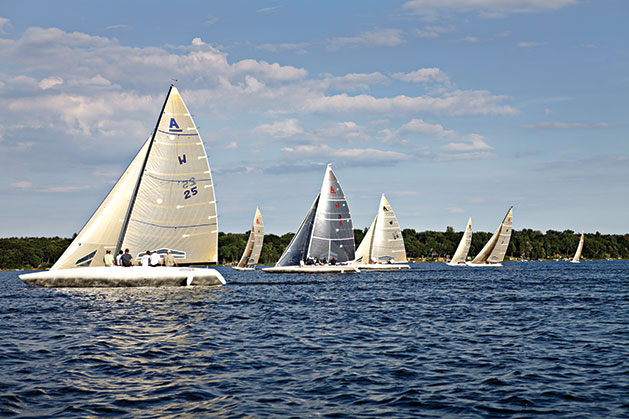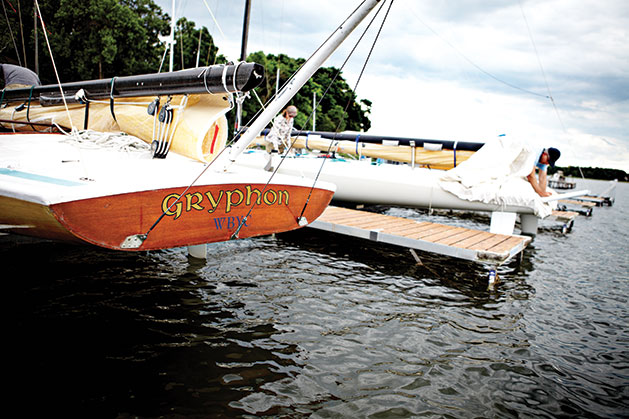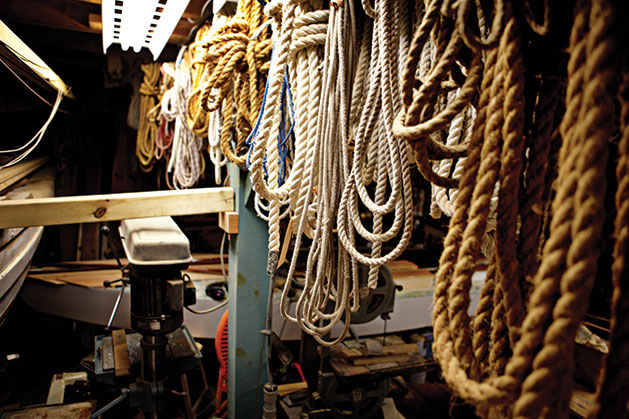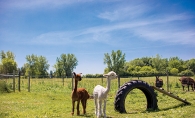Sails billow across the waters of White Bear Lake like windblown banners of royalty. This idyllic summer scene dates back to the 1800s, when the railroad reduced the three-hour dusty, wagon ride from St. Paul to White Bear Lake to a 20-minute trip. A resort boom followed, as thousands of vacationers flocked to large resorts that popped up all along the lakeshore. Naturally, these summer sojourners wanted to get out on the water. Soon, sailboats dotted the lake like flocks of elegant birds alighting on the water’s surface.

Local boat builders flourished. Most of them built keelboats with lots of weight in the keel to prevent capsizing, but they were slower and not as well suited for inland sailing. In the 1890s, boat builder J.O. Johnson, became enamored with a new sailboat design known as a flat-bottom scow. The first scow built and raced by Johnson in 1900 astounded the competition by flying past all other sailboats for numerous wins. The incredible speed of scow boats was a game-changer in the sport of sailing.
Johnson parted ways with employer Amundson Boat Works and launched Johnson Boat Works, which was dedicated to the production of the flat-bottom scow. Johnson developed many different types of scows, but the fastest and most impressive is his original 38-foot design, commonly referred to as an A scow. The large sailboat typically requires a seven-person crew, and is thrilling to watch race across the lake.
The formation of the White Bear Yacht Club in 1889 and other organizations dedicated to inter-lake racing fueled a local passion for sailing. But a 1932 storm destroyed most A scows on White Bear Lake; the Depression made rebuilding the fleet unfeasible, and Johnson Boat Works survived the era by building powerboats. Recreational sailing remained on White Bear Lake, but the expense to restore and maintain any remaining A boats made them unpractical. The A boat fell out of favor, their splendor seemingly lost forever.
A Rebirth
In 2000, Dellwood resident Fletcher Driscoll’s family included 18 people. Driscoll owned a 28-foot E boat, but says it was like a log in the water whenever his entire family attempted to board. “It was sad to have a family party and not be able to take everybody out on the boat,” says Driscoll. “So I decided to restore an older A boat.” When that happened, excitement sparked among many lake-area residents. Before long, Driscoll had a list of more than 50 friends and neighbors requesting a ride.

A year later Driscoll received a call. The last wooden scow built by Johnson Boat Works in 1963 for John S. Pillsbury was for sale. “I was sure it was too old and in bad shape,” says Driscoll. But the boat was well maintained; Driscoll bought it and, with the help of other skippers, spent a year restoring the boat to its former glory.
Driscoll figured he needed a third A boat to have races, so he added a used fiberglass A boat to his fleet and held his first A boat race in 2004. “There was more interest in these sailboats than I originally thought,” says Driscoll. Today, his A boat fleet stands at 11, the largest in the world. Driscoll gets frequent phone calls from lakefront homeowners asking when the beautiful A boats will race. “Some schedule dinner parties around sailboat races because it’s just so magical to watch,” says Driscoll.
A Family Affair
White Bear Lake has remained home to enthusiasts of smaller scows and keelboats, and the joy of sailing can be discovered at virtually any age. Craig Drake began sailing at 42 years old, shortly after he and wife Gloria enrolled their children in sailing lessons at White Bear Yacht Club. “Our kids fell in love with sailing,” says Drake, “so much so that they would note summer wind conditions and tell us whenever it was a great day to sail.” This encouraged Craig and Gloria to take adult sailing lessons.

But it was a winter visit to the boat show that sealed the sailing deal for the Drake family. “Our kids also enjoy wakeboarding and waterskiing,” says Drake. “We just assumed they’d want a speedboat, but they were enamored with sailboats from White Bear Boat Works.”
Today, the Drake family owns a 22-foot Capri keelboat named Lucky Duck and they’ve been sailing together on White Bear Lake for the past 10 years. They also have two smaller one-person laser sailboats. The Drakes race with Black Bear Yacht Racing Association, where Craig says other sailors are very helpful to beginners.
Over the years his kids have sailed in regattas with Twin Cities Youth Sailing and the high school sailing team. Last year, Lucky Duck took second place in one of Black Bear Yacht Racing Association’s series of races. “I love that sailing is a sport you can do all through life,” says Drake. “I also love the blend of art, science and strategy involved in sailboat racing.”
The Next Generation of Sailors
Sailors agree it isn’t necessary to live on a lake to enjoy sailing. The Drakes didn’t grow up on a lake and didn’t live on a lake when their initial love of sailing began. Jason Brown, owner of White Bear Boat Works, says there are many opportunities in the White Bear area for those who have never sailed before.
When Brown was 6 years old, his mother married Skip Johnson, grandson of J.O. Johnson. “I grew up hanging around the old boat works,” says Brown. “Sailing has given me fantastic memories and lifelong friends, some of whom I still compete against today.” Brown races with an A boat crew on Monday nights and says people travel to White Bear Lake from all over to race.

“I grew up sailing, but never lived on a lake,” says Kathy Sanville of White Bear Lake. “The White Bear Sailing School helps bridge the gap for sailors without lakefront property.” Sanville co-skippers Hedwig, one of Driscoll’s A boats. All of Driscoll’s A boats are named after Harry Potter characters, to pique the interest of young sailors.
Once interest is sparked, sailing classes are available at White Bear Sailing School all summer. Nick Hovland is waterfront director for WBSS and also head coach of the high school sailing team. “We have over 250 participants at the sailing school each summer, ranging from 4 to 70 years old,” says Hovland.
For kids in grades seven through 12, sailing is one of the few co-ed sports in America. It’s offered to local students spring and fall. “Many think you need to know how to sail to be on a high school team,” Hovland says. “But we take kids with zero experience and teach them to sail. All they need is a lifejacket and some waterproof clothing. We’ve had lots of success and have competed at the national level.”

Adult novices are also encouraged to take a sailing class. Adults with a little experience and lots of enthusiasm can just head out to White Bear Lake and offer to help crew sailboats during race nights. “Sailboat skippers are especially eager for extra crewmembers on windy days,” says Drake.
White Bear Lake is a social hub for the local sailing community, where enduring friendships are formed. Sailing is a lifetime sport that allows sailors to continually enjoy and challenge themselves out on the water. So, don’t just sit there: Set sail.









